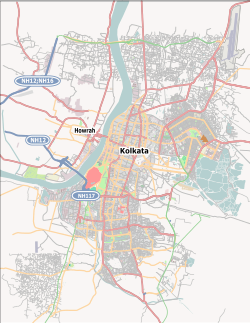| Kolkata Metro station | |||||||||||
| Dakshineswar Railway Station (in middle) building built as a replica of the iconic Dakshineswar Temple, and the Dakshineswar metro station (in right). | |||||||||||
| General information | |||||||||||
| Location | Dakshineswar, Kolkata, West Bengal 700076 | ||||||||||
| Coordinates | 22°39′14″N88°21′49″E / 22.653971°N 88.363724°E | ||||||||||
| Owned by | Metro Railway, Kolkata | ||||||||||
| Operated by | Kolkata Metro | ||||||||||
| Line(s) | Blue Line | ||||||||||
| Platforms | 2 (2 side platforms) | ||||||||||
| Tracks | 2 | ||||||||||
| Connections | | ||||||||||
| Construction | |||||||||||
| Structure type | Elevated, Double track | ||||||||||
| Parking | Yes | ||||||||||
| Accessible | Yes | ||||||||||
| Other information | |||||||||||
| Status | Operational | ||||||||||
| Station code | KDSW | ||||||||||
| History | |||||||||||
| Opened | 22 February 2021 | ||||||||||
| Services | |||||||||||
| |||||||||||
| |||||||||||
| |||||||||||
Dakshineswar is the elevated northern terminal metro station on the North-South corridor of the Blue Line of Kolkata Metro in Kolkata, West Bengal, India. The metro station adjoins the platforms of the Dakshineswar railway station where connections can be made with Indian Railways services. [1] The station is located at the Dakshineswar area which is famous for Dakshineswar Kali Temple. The station was inaugurated on 22 February 2021. [2]




